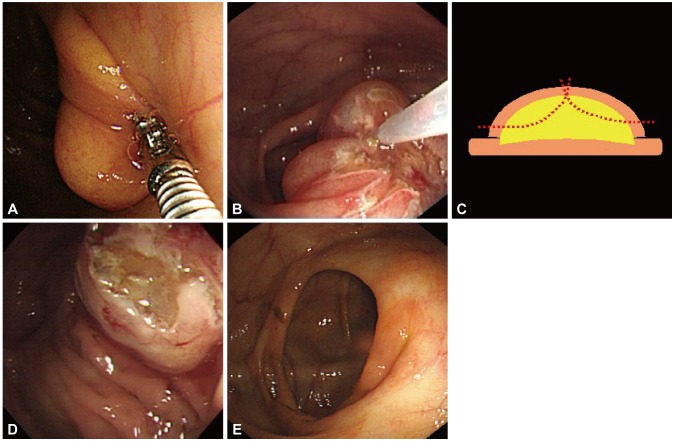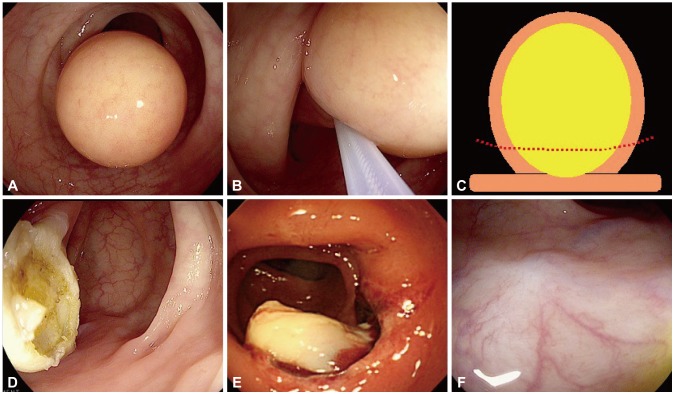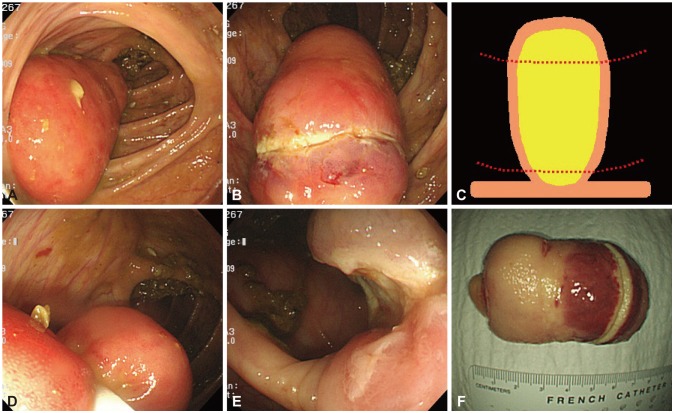Clin Endosc.
2013 Sep;46(5):586-590.
Endoscopic Resection of Giant Colonic Lipoma: Case Series with Partial Resection
- Affiliations
-
- 1Digestive Disease Center, CHA Bundang Medical Center, CHA University, Seongnam, Korea. endoscopy@cha.ac.kr
Abstract
- Colonic lipoma, a very rare form of benign tumor, is typically detected incidentally in asymptomatic patients. The size of lipoma is reported variously from 2 mm to 30 cm, with higher likelihood of symptoms as the size is bigger. Cases with symptom or bigger lesion are surgically resected in principle; endoscopic resection, which has developed recently with groundbreaking advance of endoscopic excision technology, is being used more often but with rare report of success due to high chance of complications such as bowel perforation or bleeding. The authors report here, together with a literature review, our experiences of three cases of giant colonic lipomas showing complete remission after aggressive unroofing technique, at certain intervals, using snare catheter at the origin of the lipoma so that the remaining lipoma could be drained out of the exposed surface spontaneously, in order to reduce complications.
Keyword
Figure
Reference
-
1. Michowitz M, Lazebnik N, Noy S, Lazebnik R. Lipoma of the colon: a report of 22 cases. Am Surg. 1985; 51:449–454. PMID: 4026070.2. Chung YF, Ho YH, Nyam DC, Leong AF, Seow-Choen F. Management of colonic lipomas. Aust N Z J Surg. 1998; 68:133–135. PMID: 9494006.
Article3. Zhang H, Cong JC, Chen CS, Qiao L, Liu EQ. Submucous colon lipoma: a case report and review of the literature. World J Gastroenterol. 2005; 11:3167–3169. PMID: 15918213.
Article4. Tamura S, Yokoyama Y, Morita T, Tadokoro T, Higashidani Y, Onishi S. "Giant" colon lipoma: what kind of findings are necessary for the indication of endoscopic resection? Am J Gastroenterol. 2001; 96:1944–1946. PMID: 11419863.
Article5. El-Khalil T, Mourad FH, Uthman S. Sigmoid lipoma mimicking carcinoma: case report with review of diagnosis and management. Gastrointest Endosc. 2000; 51(4 Pt 1):495–496. PMID: 10744833.
Article6. Bahadursingh AM, Robbins PL, Longo WE. Giant submucosal sigmoid colon lipoma. Am J Surg. 2003; 186:81–82. PMID: 12842756.
Article7. Mimura T, Kuramoto S, Hashimoto M, et al. Unroofing for lymphangioma of the large intestine: a new approach to endoscopic treatment. Gastrointest Endosc. 1997; 46:259–263. PMID: 9378215.
Article8. Soares JB, Gonçalves R, Rolanda C. Endoscopic resection of a large colonic lipoma by unroofing technique. Endoscopy. 2011; 43(Suppl 2 UCTN):E407. PMID: 22275025.
Article9. Matsushita M, Danbara N, Kawamata S, Omiya M, Okazaki K. Endoscopic removal of large colonic lipomas: difficult submucosal dissection or easy snare unroofing? Endoscopy. 2009; 41:475–478. PMID: 19418405.
Article10. Tascilar O, Cakmak GK, Gün BD, et al. Clinical evaluation of submucosal colonic lipomas: decision making. World J Gastroenterol. 2006; 12:5075–5077. PMID: 16937511.
Article11. Pfeil SA, Weaver MG, Abdul-Karim FW, Yang P. Colonic lipomas: outcome of endoscopic removal. Gastrointest Endosc. 1990; 36:435–438. PMID: 2227312.
Article12. Nesher E, Schreiber L, Werbin N. Bauhin's ileocecal valve syndrome-a rare cause for small-bowel obstruction: report of a case. Dis Colon Rectum. 2006; 49:527–529. PMID: 16482419.
Article13. Chase MP, Yarze JC. "Giant" colon lipoma: to attempt endoscopic resection or not? Am J Gastroenterol. 2000; 95:2143–2144. PMID: 10950091.
- Full Text Links
- Actions
-
Cited
- CITED
-
- Close
- Share
- Similar articles
-
- A Case of Giant Colonic Lipoma Showing Spontaneous Resolution after Endoscopic Partial Resection
- Case of a Giant Colonic Lipoma That Was Endoscopically Removed by Strangulation with Repetitive Endoloop Ligation
- A Case of Colonic Giant Lipoma Removed by Endoscopic Resection
- A Case of a Colonic Giant Lipoma Removed by Endoscopic Resection
- A Case of Giant Colonic Lipoma Endoscopically Removed Using an Unroofing Technique in Phases




